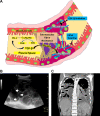Fibrin turnover and pleural organization: bench to bedside
- PMID: 29345198
- PMCID: PMC6008123
- DOI: 10.1152/ajplung.00501.2017
Fibrin turnover and pleural organization: bench to bedside
Abstract
Recent studies have shed new light on the role of the fibrinolytic system in the pathogenesis of pleural organization, including the mechanisms by which the system regulates mesenchymal transition of mesothelial cells and how that process affects outcomes of pleural injury. The key contribution of plasminogen activator inhibitor-1 to the outcomes of pleural injury is now better understood as is its role in the regulation of intrapleural fibrinolytic therapy. In addition, the mechanisms by which fibrinolysins are processed after intrapleural administration have now been elucidated, informing new candidate diagnostics and therapeutics for pleural loculation and failed drainage. The emergence of new potential interventional targets offers the potential for the development of new and more effective therapeutic candidates.
Keywords: fibrinolysis; loculation; pleural disease.
Figures

References
-
- Boren J, Shryock G, Fergis A, Jeffers A, Owens S, Qin W, Koenig KB, Tsukasaki Y, Komatsu S, Ikebe M, Idell S, Tucker TA. Inhibition of glycogen synthase kinase 3β blocks mesomesenchymal transition and attenuates streptococcus pneumonia-mediated pleural injury in mice. Am J Pathol 187: 2461–2472, 2017. doi:10.1016/j.ajpath.2017.07.007. - DOI - PMC - PubMed
Publication types
MeSH terms
Substances
Grants and funding
LinkOut - more resources
Full Text Sources
Other Literature Sources
Medical

